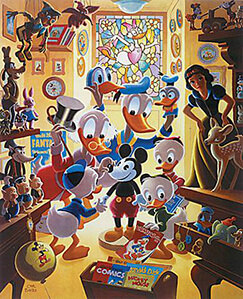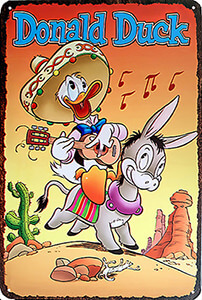
Products description
For the past forty years the content of comic books has been governed by an industry self-regulatory code adopted by publishers in 1954 in response to public and governmental pressure.
This book examines why comic books were the subject of controversy, beginning with objections that surfaced shortly after the introduction of modern comic books in the mid-1930s, when parents and teachers accused comic books of contaminating children's culture and luring children away from more appropriate reading material.
It traces how, in the years following World War II, the criticism of comic books shifted to their content, and the reading of comic books became linked with the rise of juvenile delinquency. This resulted in attempts at the local, state, and national level to ban or license comic book sales.
A major figure in the crusade against comic books was the psychiatrist Dr. Fredric Wertham. While he played a significant role in the postwar attack on comics, his accusations against the comic book industry have been misunderstood by comic book fans and media scholars alike. They have accused him of being a naive social scientist who saw direct causal links between the reading of comic books and delinquency. In fact, Seal of Approval shows that Wertham's work is much better understood in the intellectual tradition of media criticism of the Frankfurt school and their critique of mass culture.
The negative publicity aroused by the controversy, coupled with fears that the government would pass censorship legislation, led publishers to adopt the self-regulatory code. It has been changed only twice, once in 1971 and again in 1989.
The legacy of the comics code is that it continues to define the comic book medium as essentially juvenile literature. While the code offers protection against those who attack the media (and not just comic books), it also reaffirms the public perception of comic books as children's fare. As a result, the comic book has yet to achieve legitimation as a unique form of expression that blends words and pictures in a way that no other medium can duplicate.
In tracing the evolution of the controversy and the resulting code Seal of Approval examines important issues about children, media effects, and censorship. It is the first book-length scholarly study of this period of comic book history.
This book examines why comic books were the subject of controversy, beginning with objections that surfaced shortly after the introduction of modern comic books in the mid-1930s, when parents and teachers accused comic books of contaminating children's culture and luring children away from more appropriate reading material.
It traces how, in the years following World War II, the criticism of comic books shifted to their content, and the reading of comic books became linked with the rise of juvenile delinquency. This resulted in attempts at the local, state, and national level to ban or license comic book sales.
A major figure in the crusade against comic books was the psychiatrist Dr. Fredric Wertham. While he played a significant role in the postwar attack on comics, his accusations against the comic book industry have been misunderstood by comic book fans and media scholars alike. They have accused him of being a naive social scientist who saw direct causal links between the reading of comic books and delinquency. In fact, Seal of Approval shows that Wertham's work is much better understood in the intellectual tradition of media criticism of the Frankfurt school and their critique of mass culture.
The negative publicity aroused by the controversy, coupled with fears that the government would pass censorship legislation, led publishers to adopt the self-regulatory code. It has been changed only twice, once in 1971 and again in 1989.
The legacy of the comics code is that it continues to define the comic book medium as essentially juvenile literature. While the code offers protection against those who attack the media (and not just comic books), it also reaffirms the public perception of comic books as children's fare. As a result, the comic book has yet to achieve legitimation as a unique form of expression that blends words and pictures in a way that no other medium can duplicate.
In tracing the evolution of the controversy and the resulting code Seal of Approval examines important issues about children, media effects, and censorship. It is the first book-length scholarly study of this period of comic book history.
Antiquarian
Former library copy.
Condition 0 (mint MT)
An exceptional example of a given book. Bindery or printing defects are allowed. Cover is flat with no surface wear. Inks are bright with high reflectivity. Corners are cut square and sharp. Spine is tight and flat. Paper is white, supple and fresh. No interior autographs or owner signatures.
Condition 0-1 (near mint NM)
Nearly perfect in every way with only minor imperfections that keep it from the next higher grade. Only subtle bindery or printing defects are allowed. Cover is flat with no surface wear. Inks are bright with high reflectivity and minimal fading. Corners are cut square and sharp. Small, inconspicuous, lightly penciled, stamped or inked arrival dates are acceptable as long as they are in an unobtrusive location. Spine is tight and flat. Paper is white, supple and fresh. Only the slightest interior tears are allowed.
Condition 1 (very fine VF)
An above-average copy that shows minor wear but is still relatively flat and clean with outstanding eye appeal. A small accumulation of minor bindery/printing defects is allowed. Minor cover wear beginning to show, possibly including minor creases. Corners may be blunted. Stamped or inked arrival dates may be present. Minor foxing. Paper is cream to tan. Centerfold is mostly secure. Minor interior tears at the margin may be present.
Condition 1-2 (fine FN)
An above-average copy that shows minor wear but is still relatively flat and clean with no significant creasing or other serious defects. Some accumulation of minor bindery/printing defects is allowed. Minor cover wear apparent, with minor to moderate creases. Inks show a significant reduction in reflectivity. Blunted corners are more common, as is minor staining, soiling, discoloration, and/or foxing. Stamped or inked arrival dates may be present. Paper is tan to brown and fairly supple with no signs of brittleness. Minor interior tears at the margin may be present. Centerfold may be loose.
Condition 2 (very good/fine VG-FN)
An above-average but well used book. An accumulation of bindery/printing defects is allowed. Minor to moderate cover wear apparent, with minor to moderate creases and/or dimples. Inks have moderate to low reflectivity. Blunted corners are increasingly common, as is minor to moderate staining, discoloration, and/or foxing. Stamped or inked arrival dates may be present. Paper is tan to brown with no signs of brittleness. Centerfold may be loose. Minor interior tears may also be present.
Condition 2-3 (very good VG)
The average used book. Cover shows moderate to significant wear, and may be loose but not completely detached. Cover reflectivity is low. Can have moderate creases or dimples. Corners may be blunted. Store stamps, name stamps, arrival dates, initials, etc. have no effect on this grade. Some discoloration, fading, foxing, and even minor soiling is allowed. As much as a 1/4" triangle can be missing out of the corner or edge; a missing 1/8" square is also acceptable. Moderate spine roll may be present and/or a 1" spine split. Paper is brown but not brittle. Minor to moderate interior tears may be present. Centerfold may be loose or detached at one staple.
Condition 3 (good GD)
Cover shows significant wear and may even be detached. Cover reflectivity is low and in some cases completely absent. Book-length creases and dimples may be present. Rounded corners are more common. Moderate soiling, staining, discoloration and foxing may be present. The largest piece allowed missing from the front or back cover is usually a 1/2" triangle or a 1/4" square. Tape and other forms of amateur repair are common in older books. Spine roll is likely. May have up to a 2" spine split. Paper is brown but not brittle. Centerfold may be loose or detached. Moderate interior tears may be present.
According to § 19 UStG., we charge no sales tax
modified eCommerce Shopsoftware © 2009-2024
modified eCommerce Shopsoftware © 2009-2024



 Contact
Contact





